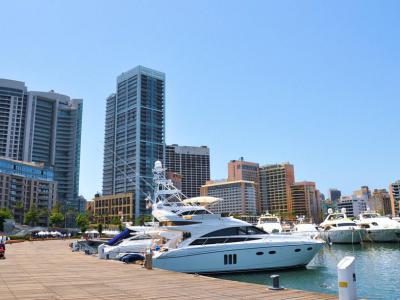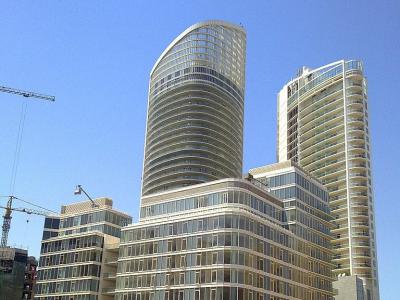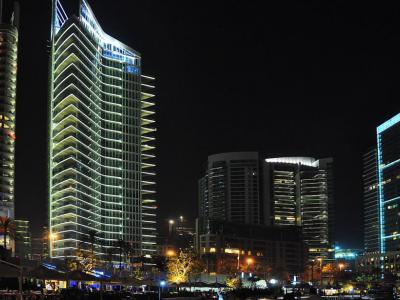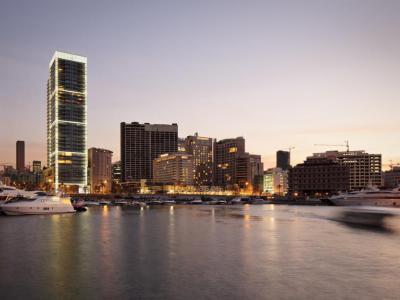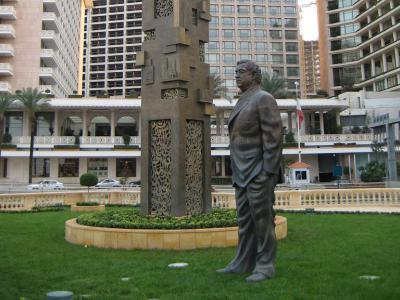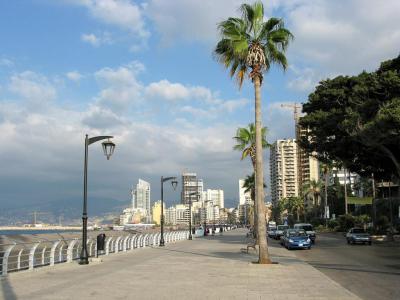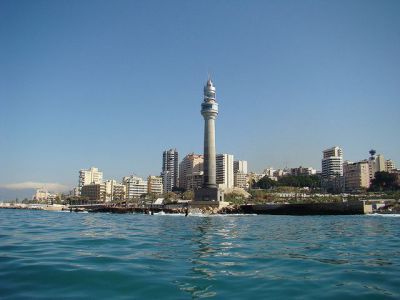
Seaside Walking Tour (Self Guided), Beirut
If you wish to unwind or, perhaps, seek some quality time with your family and friends in a completely safe environment, while in Beirut, the local seaside area offers ample opportunities for both. Lined with palm trees, the city's waterfront guarantees a truly joyful experience and is as much fun for watching the Mediterranean, beautiful people and breathing the air as it is for exploring the coastline.
Strolling down the elegantly landscaped 10 meter-wide pedestrian boardwalk surrounding Beirut Marina, which is dominated by prominent high-rising Beirut and Platinum Towers, the promenade passes Zaitunay Bay with all its boats and quays, restaurants and cafés, before breaking into a series of overlapping platforms as a new extension to the famous Corniche esplanade. Extant since the days of the French colony, the Corniche itself is inflated to create an ‘urban beach,’ with levels subtly articulated to provide outdoor spaces with public areas for artwork, jogging, and outlets offering a wide range of Lebanese snacks and drinks.
Marina Towers, a residential complex located near the Marina, takes its shape from the strata and layers in forking vectors; its horizontal layers have been inspired by the planar lapping waves of the sea that once washed the ancient beach on this site.
Among other sights worthy of attention are the Rafik Al Hariri Memorial and New Lighthouse Al Manara.
For a detailed discovery of Beirut's seashore, especially in the evening, take this self-guided walking tour and enjoy the fantastic location in its full splendor!
Strolling down the elegantly landscaped 10 meter-wide pedestrian boardwalk surrounding Beirut Marina, which is dominated by prominent high-rising Beirut and Platinum Towers, the promenade passes Zaitunay Bay with all its boats and quays, restaurants and cafés, before breaking into a series of overlapping platforms as a new extension to the famous Corniche esplanade. Extant since the days of the French colony, the Corniche itself is inflated to create an ‘urban beach,’ with levels subtly articulated to provide outdoor spaces with public areas for artwork, jogging, and outlets offering a wide range of Lebanese snacks and drinks.
Marina Towers, a residential complex located near the Marina, takes its shape from the strata and layers in forking vectors; its horizontal layers have been inspired by the planar lapping waves of the sea that once washed the ancient beach on this site.
Among other sights worthy of attention are the Rafik Al Hariri Memorial and New Lighthouse Al Manara.
For a detailed discovery of Beirut's seashore, especially in the evening, take this self-guided walking tour and enjoy the fantastic location in its full splendor!
How it works: Download the app "GPSmyCity: Walks in 1K+ Cities" from Apple App Store or Google Play Store to your mobile phone or tablet. The app turns your mobile device into a personal tour guide and its built-in GPS navigation functions guide you from one tour stop to next. The app works offline, so no data plan is needed when traveling abroad.
Seaside Walking Tour Map
Guide Name: Seaside Walking Tour
Guide Location: Lebanon » Beirut (See other walking tours in Beirut)
Guide Type: Self-guided Walking Tour (Sightseeing)
# of Attractions: 7
Tour Duration: 2 Hour(s)
Travel Distance: 3.2 Km or 2 Miles
Author: rose
Sight(s) Featured in This Guide:
Guide Location: Lebanon » Beirut (See other walking tours in Beirut)
Guide Type: Self-guided Walking Tour (Sightseeing)
# of Attractions: 7
Tour Duration: 2 Hour(s)
Travel Distance: 3.2 Km or 2 Miles
Author: rose
Sight(s) Featured in This Guide:
- Zaitunay Bay
- Marina Towers
- Beirut Tower
- Platinum Tower
- Rafik Al Hariri Memorial
- Corniche (Waterfront Promenade)
- New Lighthouse Al Manara
1) Zaitunay Bay (must see)
Zaitunay Bay is a harbor project, recently completed, around Beirut Marina. It is a wonderful part of town to explore, walk the promenade and people watch. There are restaurants with Lebanese and international cuisine, cafes and shopping options.
The project is conceived as an urban beach. The Beirut Corniche and the new sea promenade are broadened by overlapping layered platforms resembling sea waves. This modification affords more outdoor public spaces for artworks and exhibitions. The Quayside Restaurant Strip has over 17 restaurants and retail locations.
The strip runs alongside the Beirut Marina from the west border to the Yacht Club in the east. The single floor strip is below street level. The roofs of the strip are made to act as a continuation of the Corniche. The entry plaza, the quayside and the Corniche walkway form terraces resembling a stony "beach" over the cafes and shops.
The Yacht Club part of the development was completed in 2014. The Club has ample mooring space for most vessels. It has a clubhouse and nine club suites with facilities on two levels. On the lower level there is a swimming pool deck with bar, a restaurant, lounge, library, games room and gym.
The best time to visit Zaitunay Bay is in early evening when the setting sun illuminates the Mediterranean Sea.
The project is conceived as an urban beach. The Beirut Corniche and the new sea promenade are broadened by overlapping layered platforms resembling sea waves. This modification affords more outdoor public spaces for artworks and exhibitions. The Quayside Restaurant Strip has over 17 restaurants and retail locations.
The strip runs alongside the Beirut Marina from the west border to the Yacht Club in the east. The single floor strip is below street level. The roofs of the strip are made to act as a continuation of the Corniche. The entry plaza, the quayside and the Corniche walkway form terraces resembling a stony "beach" over the cafes and shops.
The Yacht Club part of the development was completed in 2014. The Club has ample mooring space for most vessels. It has a clubhouse and nine club suites with facilities on two levels. On the lower level there is a swimming pool deck with bar, a restaurant, lounge, library, games room and gym.
The best time to visit Zaitunay Bay is in early evening when the setting sun illuminates the Mediterranean Sea.
2) Marina Towers
Marina Towers is a residential complex near the Beirut Marina, and consists of a high-rise apartment building - Marina Tower, and two mid-rise apartment buildings - Marina Court and Marina Garden. Designed by renowned architect firm Kohn Pedersen Fox Associates, Marina Towers is built on over 7,000 sq meters of land with the main tower reaching a height of 150 meters, making it the second tallest building in Lebanon. The Marina Towers project is currently the biggest and most prestigious residential undertaking in the Mediterranean. It is a natural part of Beirut itself and features ultra luxurious simplex and duplex apartments and a penthouse with a private pool.
The orientation of the Marina Tower is set on the radial axis of the harbor, emphasizing its vital link with the Beirut Western Marina.
A crescent shape has been used in the design of the structure to incorporate the naturally rounded forms of waterfront architecture and provide each of the apartments with dramatic panoramas to the sea, the mountains, the Beirut Central District Park and the Marina. The contemplative, clean-lined architecture consists of 26 floors that stretch 150m above sea level. The entire structure uses stone and glass with a combination of aluminum curtain walls and clear double-glazing that extends all the way to the top.
Residents with boats can use a nearby floating slip that gives access to the sea.
Directly adjacent to the Marina Tower is the Marina Garden, an area offering the choice of smaller, units that are surrounded by over 3,000 square metres of gardens.
As a complement to the Tower and Garden, the Court offers space with smaller, more adaptable, modular surface areas that allow for a possible expansion by joining apartments.
The orientation of the Marina Tower is set on the radial axis of the harbor, emphasizing its vital link with the Beirut Western Marina.
A crescent shape has been used in the design of the structure to incorporate the naturally rounded forms of waterfront architecture and provide each of the apartments with dramatic panoramas to the sea, the mountains, the Beirut Central District Park and the Marina. The contemplative, clean-lined architecture consists of 26 floors that stretch 150m above sea level. The entire structure uses stone and glass with a combination of aluminum curtain walls and clear double-glazing that extends all the way to the top.
Residents with boats can use a nearby floating slip that gives access to the sea.
Directly adjacent to the Marina Tower is the Marina Garden, an area offering the choice of smaller, units that are surrounded by over 3,000 square metres of gardens.
As a complement to the Tower and Garden, the Court offers space with smaller, more adaptable, modular surface areas that allow for a possible expansion by joining apartments.
Sight description based on Wikipedia.
3) Beirut Tower
Beirut Tower is a 25-storey residential development on Beirut’s seafront. Located by the Zaitunay Bay, on Fawsi Daouk Street near the beachfront, this luxurious high-riser offers a stunning view of the sea and Lebanon mountains.
The Beirut Tower stands next door to the Bay Tower, also known as the New Beirut Tower. Since the city reconstruction began after the civil war, high-rising towers have been popping up along the shore like mushrooms.
Being one of them, this tower can be frankly described as "skyscraper." It follows a postmodernist style with curtained wall facades. The building features gray granite walls and glazed balustrades, and has three separate entrances. The main entrance is a glass atrium, five stories high. Within the atrium is a garden with natural light.
Originally, slabs for this project were designed 400mm-thick, but then the thickness was reduced to 250mm in order to create a more spacious, flexible interior. The overall construction area of 50,000 m2 ensures an average floor area of approximately 2,000 m2. The floor-to-floor height is about 11 feet.
Other than saving the materials and construction time, thinner slabs had enabled the creation of an extra storey within the original design. In addition to the 25 floors above street level there are also four floors below.
The Beirut Tower stands next door to the Bay Tower, also known as the New Beirut Tower. Since the city reconstruction began after the civil war, high-rising towers have been popping up along the shore like mushrooms.
Being one of them, this tower can be frankly described as "skyscraper." It follows a postmodernist style with curtained wall facades. The building features gray granite walls and glazed balustrades, and has three separate entrances. The main entrance is a glass atrium, five stories high. Within the atrium is a garden with natural light.
Originally, slabs for this project were designed 400mm-thick, but then the thickness was reduced to 250mm in order to create a more spacious, flexible interior. The overall construction area of 50,000 m2 ensures an average floor area of approximately 2,000 m2. The floor-to-floor height is about 11 feet.
Other than saving the materials and construction time, thinner slabs had enabled the creation of an extra storey within the original design. In addition to the 25 floors above street level there are also four floors below.
4) Platinum Tower
Platinum Tower is a highrise residential building currently the tallest in Beirut. It occupies a large plot on the Saint George Bay Marina, and will be connected to the marina in the future by a pedestrian bridge.
It currently holds the status as the tallest building in Beirut at 153 m height, only to be eclipsed by the currently under-construction 195-meters-high Sama Beirut tower in the Achrafieh district of Beirut. The platinum has gradually occupied a significant location on the seafront, thus becoming an unmissable icon on Beirut's skyline.
The tower neighbors several luxurious hotels like the InterContinental Phoenicia Beirut Hotel, the Monroe Hotel, Le Vendôme Intercontinental Hotel, Grand Hyatt and the Four Seasons Hotel. It is also adjacent to several landmarks including the Rafik Hariri memorial, the St. Elias Cathedral, the Corniche Beirut, All Saints Church, Beirut International Exhibition & Leisure Center, and the bullet-riddled Holiday Inn Hotel, one of the last witnesses to Beirut's destructive civil war.
The Platinum Tower consists of two single buildings, the smaller one at the sea side, the lower one overlooking the Beirut Central District.
The house is illuminated at night at its edges, and on top, additionally with horizontal light lines at every ninth floor.
It currently holds the status as the tallest building in Beirut at 153 m height, only to be eclipsed by the currently under-construction 195-meters-high Sama Beirut tower in the Achrafieh district of Beirut. The platinum has gradually occupied a significant location on the seafront, thus becoming an unmissable icon on Beirut's skyline.
The tower neighbors several luxurious hotels like the InterContinental Phoenicia Beirut Hotel, the Monroe Hotel, Le Vendôme Intercontinental Hotel, Grand Hyatt and the Four Seasons Hotel. It is also adjacent to several landmarks including the Rafik Hariri memorial, the St. Elias Cathedral, the Corniche Beirut, All Saints Church, Beirut International Exhibition & Leisure Center, and the bullet-riddled Holiday Inn Hotel, one of the last witnesses to Beirut's destructive civil war.
The Platinum Tower consists of two single buildings, the smaller one at the sea side, the lower one overlooking the Beirut Central District.
The house is illuminated at night at its edges, and on top, additionally with horizontal light lines at every ninth floor.
Sight description based on Wikipedia.
5) Rafik Al Hariri Memorial
Rafic Hariri, the Prime Minister of Lebanon, was assassinated on this spot in 2005 in a car bomb attack which also took the lives of 22 civilians and several Hariri's bodyguards.
The Cedar Revolution which followed Hariri's assassination partly carried out his wishes for a free and independent Lebanon. The Memorial to the late Prime Minister, who symbolized the possibility of unity in the country and paid the ultimate price for that, is set near St George's Hotel. It features a statue of Rafik Hariri, a sculptural piece, and a torch.
The nearby commemorative garden, situated on a steeply sloping triangular site below the Grand Serail (Government Palace), pays tribute to Hariri's vision and achievements. Its steps symbolize gradual rebuilding of Beirut and an open invitation to the city; the granite planes represent sobriety and perseverance; the flowing water mirrors embody continuity; and a row of flowering Jacaranda trees evokes life’s constant renewal.
The Cedar Revolution which followed Hariri's assassination partly carried out his wishes for a free and independent Lebanon. The Memorial to the late Prime Minister, who symbolized the possibility of unity in the country and paid the ultimate price for that, is set near St George's Hotel. It features a statue of Rafik Hariri, a sculptural piece, and a torch.
The nearby commemorative garden, situated on a steeply sloping triangular site below the Grand Serail (Government Palace), pays tribute to Hariri's vision and achievements. Its steps symbolize gradual rebuilding of Beirut and an open invitation to the city; the granite planes represent sobriety and perseverance; the flowing water mirrors embody continuity; and a row of flowering Jacaranda trees evokes life’s constant renewal.
6) Corniche (Waterfront Promenade) (must see)
Corniche is a seaside promenade in the Central District of Beirut. A pleasant walkway, it has palm trees and great views of the sea in the west and Mount Lebanon in the east. It is an extension of the French Avenue, built during the time of the French Mandate for Syria and Lebanon. Some trees are bullet-scarred, a reminder of the civil war.
The Corniche is three miles long. It wraps around the promontory of Saint George Bay, turns west into Place Rafic Hariri, the Paris Avenue, and into the Avenue General de Gaulle, ending at Rafic Hariri Avenue. It is a favorite locale for strollers, joggers, and bicycles. Push carts offer snacks and drinks.
In 2001, seventy-six concrete benches lining the promenade were replaced with new benches sporting colored ceramics designed by the Lebanese artist Lena Kelekian. Lena also designed the Mega Chessboard on the broadest part of the walk by the Paris Avenue. The railings along the walk have been modified to keep daredevils from diving off the rails.
The Corniche is three miles long. It wraps around the promontory of Saint George Bay, turns west into Place Rafic Hariri, the Paris Avenue, and into the Avenue General de Gaulle, ending at Rafic Hariri Avenue. It is a favorite locale for strollers, joggers, and bicycles. Push carts offer snacks and drinks.
In 2001, seventy-six concrete benches lining the promenade were replaced with new benches sporting colored ceramics designed by the Lebanese artist Lena Kelekian. Lena also designed the Mega Chessboard on the broadest part of the walk by the Paris Avenue. The railings along the walk have been modified to keep daredevils from diving off the rails.
7) New Lighthouse Al Manara
The words "Al Manara" in Arabic mean, "the Lighthouse." Beirut has had five different lighthouses since the 19th century. By the early 1800s Beirut had become a vital maritime nexus between east and west. To guide ships safely, the lighthouses were erected in succession at the tip of land called Ras-Beirut.
All five lighthouses have been operated by the Chablis family. The first lighthouse was a brick tower, a little less than fifty feet high and it burned kerosene. The second light, built in the 1920s, was on a little higher ground than the first. It was concrete, measuring 66 feet in height. In 1990 it was renovated by order of President Hrawe.
The third lighthouse was also built in Ras-Beirut. It's construction followed the loss of the French ship Champollion in 1952. The ship's navigator confused the lighthouse with the lights of the airport while trying for the harbor. The second lighthouse was replaced.
The third lighthouse and the fourth lighthouse were darkened by war and by subsequent shoreside constructions after the war that obscured them from the sea. In 2003 Beirut's fifth lighthouse was built. It is situated well away from built-up areas at the edge of the waterfront. It is 118 feet high, its light flashes white two times, every ten seconds.
All five lighthouses have been operated by the Chablis family. The first lighthouse was a brick tower, a little less than fifty feet high and it burned kerosene. The second light, built in the 1920s, was on a little higher ground than the first. It was concrete, measuring 66 feet in height. In 1990 it was renovated by order of President Hrawe.
The third lighthouse was also built in Ras-Beirut. It's construction followed the loss of the French ship Champollion in 1952. The ship's navigator confused the lighthouse with the lights of the airport while trying for the harbor. The second lighthouse was replaced.
The third lighthouse and the fourth lighthouse were darkened by war and by subsequent shoreside constructions after the war that obscured them from the sea. In 2003 Beirut's fifth lighthouse was built. It is situated well away from built-up areas at the edge of the waterfront. It is 118 feet high, its light flashes white two times, every ten seconds.
Walking Tours in Beirut, Lebanon
Create Your Own Walk in Beirut
Creating your own self-guided walk in Beirut is easy and fun. Choose the city attractions that you want to see and a walk route map will be created just for you. You can even set your hotel as the start point of the walk.
Beirut Introduction Walking Tour
How many times can a city die? Beirut, in 5,000 years, has died and come back many times. Archeological digs downtown have revealed Phoenician, Greek, Roman, Byzantine, Arab, Crusader and Ottoman remains and signs of influence.
In 140 BC the city was destroyed by Diodotus Tryphon, a king of the Seleucid Empire. His Hellenistic city lies over the Phoenician one. Pompey the Great arrived in 64 BC... view more
Tour Duration: 2 Hour(s)
Travel Distance: 3.3 Km or 2.1 Miles
In 140 BC the city was destroyed by Diodotus Tryphon, a king of the Seleucid Empire. His Hellenistic city lies over the Phoenician one. Pompey the Great arrived in 64 BC... view more
Tour Duration: 2 Hour(s)
Travel Distance: 3.3 Km or 2.1 Miles
The Most Popular Cities
/ view all
